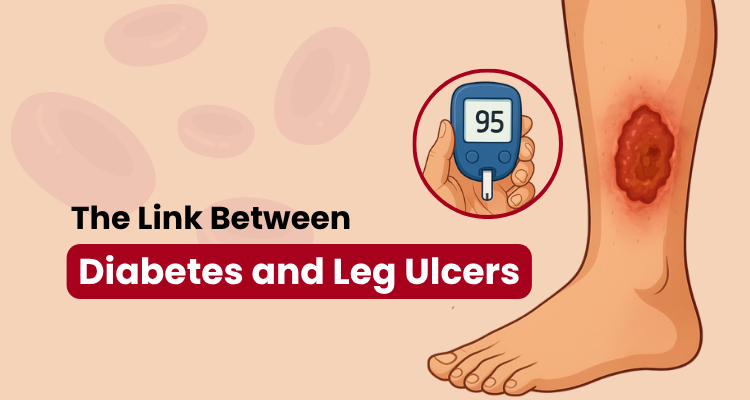Have you heard that leg ulcers affect 15% of people with diabetes at some point in their lives? Uncontrolled diabetes can, without a trace, harm your nerves and blood vessels so that you lose sensitivity and blood flow becomes slow. That is why what seems like a simple, minor scratch can develop into a dangerous infection.
Poor blood supply and nerve damage gradually raise the risk of the development of open sores and diabetic foot or leg ulcers, which may become non-healing wounds if you do not get early treatment. Hence, foot ulcers with diabetes require proper care in time so as not to cause further tissue damage and dangerous disorders like amputation.
It is possible to control diabetes causing leg ulcers by noticing and recognising the common symptoms, as well as seeking the right treatment. Let’s discuss in detail!
What are Diabetic Foot and Leg Ulcers?
Diabetic foot and leg ulcers are open sores or wounds that appear as a result of nerve damage, low blood supply, or infections related to diabetes. Ulcers are often common in those with uncontrolled blood sugar. Narrowed lower limb arteries, usually caused by peripheral artery disease and decreased oxygen supply, allow ulcers to form.
Slowly healing wounds tend to become chronic or infected unless given proper treatment. Arterial ulcers are most commonly found on the heels or toes, neurotrophic ulcers are mostly located on the soles, and venous stasis ulcers are generally present on the legs. Research shows that some patients who get ulcers on feet from diabetes may result in the need for amputations if no intervention is taken on time.
How Diabetes Causes Leg Ulcers
- Neuropathy
Prolonged high blood sugar causes nerve damage. This affects the feet in most cases. The very first signs are tingling, burning sensations or pain. When nerves lose their sensitivity, patients may not feel that their feet have been cut, blistered, or rubbed. What starts as a small wound that is not noticed will gradually become an open sore that requires the intervention of a professional.
- Blood Vessel Damage
High blood sugar destroys small and large arteries. Weakened arteries in the feet restrict oxygen and nutrient delivery. This slows down healing and increases the risk of infection. Peripheral artery disease worsens circulation issues, as cholesterol and fat deposits narrow arteries in the lower limbs. Reduced oxygen delivery can lead to arterial ulcers on the ankles, lower legs, and feet.
Risks of Diabetic Ulcers
Diabetic ulcers do not heal on their own and will continue to get worse with time. These wounds have the capability of destroying skin, tissue, and bones if left untreated. Such infections can become so severe that gangrene and bone infection may develop, hence making diabetes and leg ulcer the leading cause of lower-limb amputation.
According to figures, over 50% of all amputations are associated with diabetes and peripheral artery disease. The safeguarding against these ailments by means of appropriate monitoring and timely reaction is capable of keeping these dangerous sequelae at bay, together with the preservation of the patient’s freedom of movement and the general improvement of the diabetic condition.
Role of Interventional Radiology in Treatment
One of the major contributors to the relief of diabetic foot complications is interventional radiology (IR). The selected minimally invasive procedures are done under the guidance of imaging by an interventional radiologist in Mumbai. The therapies are directed in a very pinpointed manner, not only to bring back the blood flow but also to heal the ulcers effectively.
The management of the diabetic foot usually involves the use of standard methods along with cutting-edge IR techniques to make the healing faster and the chances of complications smaller.
- Advanced Imaging Techniques
Imaging devices like Doppler ultrasound, magnetic resonance angiography, and computed tomography angiography evaluate blood circulation and identify artery blockage in the legs and feet. Effective imaging aids in the treatment planning and monitoring of the development of ulcers.
- Angioplasty
Peripheral Artery Disease (PAD) lowers the blood supply to the feet and, as a result, facilitates the development of ulcers. One way to treat this is by an angioplasty, which an interventional radiologist carries out to remove the artery blockage. Sometimes a stent is placed in the artery to keep it open. Reduced risk of amputation is one of the effects of better blood flow after the wound is healed.
- Thrombolysis and Mechanical Thrombectomy
Clots in the arteries make ulcers worse. Clots are destroyed by thrombolysis after the application of the drug directly into the arteries that are involved. Mechanical thrombectomy is about getting rid of the clots with the help of some introducer tools. In this conjunction, blood flow is resumed, infection risk is reduced, and ulcer healing is facilitated.
Advantages of Interventional Radiology
- Minimally Invasive Procedures
IR techniques involve smaller cuts in comparison to regular surgery, leading to quicker recovery and fewer complications.
- Accuracy and Precision
Latest imaging enables physicians to identify affected tissues with accuracy, maximising the effectiveness of treatment.
- Shorter Hospital Stays
Most IR procedures are done on an outpatient basis, lowering the need for hospitalisation and enhancing patient convenience.
- Better Outcomes
Healing becomes faster with the return of blood flow, and the chance of amputation is significantly reduced. Many case histories of diabetic foot treatment in Mumbai show that patients who had severe peripheral arterial disease (PAD) or several clots got their ulcers totally healed after angioplasty, stenting, or thrombolysis.
Preventing Diabetic Leg Ulcers
An individual with diabetes must monitor foot and leg health regularly. Daily checks, good hygiene, well-fitting shoes, and early intervention for small injuries prevent complications. Keeping blood sugars under control also promotes nerve and blood vessel health.
Combining these habits with medical attention, including interventional radiology when needed, the risk of diabetic ulcers leg and serious infection is significantly reduced.
Who is at Higher Risk of Developing Diabetes?
Certain individuals with diabetes are at greater risk of getting diabetic wound in leg because of existing conditions or lifestyle factors. Those most at risk include
- Patients who have poor circulation or peripheral artery disease
- People who have high blood pressure or hypertension
- A person who has deformities of the feet, like bunions or hammer toes
- Overweight or obese individuals
- Patients who cannot keep their blood sugar levels stable
- Regular tobacco or cigarette smokers
All these factors together impair circulation, delay healing of wounds, and increase infection risk, making prevention of ulcers a top priority in the care of diabetes.
To Conclude
If left untreated, diabetic foot and leg ulcers may cause severe complications. Therefore, the most important thing is to provide treatment as soon as possible. The healing process can be supported by a variety of advanced therapies, such as interventional radiology, which also helps in lowering the probability of an amputation.
Dr. Kunal Arora, a leading expert in the field of interventional radiology in Mumbai, is the right person to help you with your diabetic leg infection and diabetes. His unique care approach will enable you to get a quicker recovery, blood flow will be normalised, and you will be able to stop the damage from progressing.
To protect your overall health from leg ulcers and diabetes, call today to consult with Dr. Kunal Arora.


